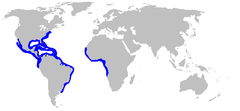Lemon shark: Difference between revisions
Tassedethe (talk | contribs) m WikiCleaner 0.99 - Repairing link to disambiguation page - (You can help) |
|||
| Line 36: | Line 36: | ||
==Importance to humans== |
==Importance to humans== |
||
Lemon sharks are a popular choice for study by scientists as they survive well in captivity, unlike many other species such as the [[great white]], which die in captivity because of food refusal. The species is the best known of all sharks in terms of behaviour and [[ecology]], mainly thanks to the enormous effort of [[Samuel H. Gruber|Samuel Gruber]] at the [[University of Miami]] who has been studying the lemon shark both in the field and in the laboratory since 1967. The population around the [[Bimini Islands]] in the western [[Bahamas]], where Gruber's field station, Bimini Biological Field Station, is situated, is probably the best known of all shark populations. As of 2007, it is experiencing a severe population decline and may disappear altogether due to destruction of the mangroves for construction of a golf [[resort]]. There have been 22 known lemon shark attacks since 1580 with no deaths. |
Lemon sharks are a popular choice for study by scientists as they survive well in captivity, unlike many other species such as the [[great white]], which die in captivity because of food refusal. The species is the best known of all sharks in terms of behaviour and [[ecology]], mainly thanks to the enormous effort of [[Samuel H. Gruber|Samuel Gruber]] at the [[University of Miami]] who has been studying the lemon shark both in the field and in the laboratory since 1967. The population around the [[Bimini Islands]] in the western [[Bahamas]], where Gruber's field station, Bimini Biological Field Station, is situated, is probably the best known of all shark populations. As of 2007, it is experiencing a severe population decline and may disappear altogether due to destruction of the mangroves for construction of a golf [[resort]]. There have been 22 known lemon shark attacks since 1580 with no deaths.the are all died |
||
==Electroreceptors== |
==Electroreceptors== |
||
Revision as of 18:55, 29 November 2010
This article includes a list of references, related reading, or external links, but its sources remain unclear because it lacks inline citations. (April 2009) |
| Lemon shark | |
|---|---|

| |
| Scientific classification | |
| Kingdom: | |
| Phylum: | |
| Class: | |
| Subclass: | |
| Order: | |
| Family: | |
| Genus: | |
| Binomial name | |
| Negaprion brevirostris (Poey, 1868)
| |

| |
| Range of the lemon shark | |
| Synonyms | |
|
Carcharias fronto Jordan & Gilbert, 1882 | |
The lemon shark, Negaprion brevirostris, is a shark that belongs to the family Carcharhinidae that can grow 10 feet (3.0 m) long.[1]
Distribution and habitat
The lemon shark is found mainly along the subtropical and tropical parts of the Atlantic and Pacific coasts of North and South America, and around Pacific Islands. The longest lemon shark recorded was 13 ft long, but they are usually 8 to 10 ft (3.0 m). They like tropical water, and like to stay at moderate depths. Lemon sharks are often accompanied by remoras.
Reproduction
Lemon sharks are viviparous, females giving birth to between 4 and 17 young every other year in warm and shallow lagoons. The young have to fend for themselves and remain in shallow water near mangroves until they grow larger. With increasing size, the sharks venture further away from their birth place. At maturity at a size of 1.5 to 2 m and an age of 12 to 15 years, they leave shallow water and move into deeper waters offshore. However, little is known of this life stage. Maximum recorded length and weight is 340 cm and 183 kg.[2]
Recent work in genetics by Kevin Feldheim and Sonny 'Doc' Gruber may suggest that adult sharks move over hundreds of km to mate, or populations far apart may have been separated in recent time. Further research in this area would be of immense importance for the understanding of the lemon shark's breeding behaviour and ecology.
Importance to humans
Lemon sharks are a popular choice for study by scientists as they survive well in captivity, unlike many other species such as the great white, which die in captivity because of food refusal. The species is the best known of all sharks in terms of behaviour and ecology, mainly thanks to the enormous effort of Samuel Gruber at the University of Miami who has been studying the lemon shark both in the field and in the laboratory since 1967. The population around the Bimini Islands in the western Bahamas, where Gruber's field station, Bimini Biological Field Station, is situated, is probably the best known of all shark populations. As of 2007, it is experiencing a severe population decline and may disappear altogether due to destruction of the mangroves for construction of a golf resort. There have been 22 known lemon shark attacks since 1580 with no deaths.the are all died
Electroreceptors
All sharks have electroreceptors concentrated in their heads called the Ampullae of Lorenzini. These receptors detect electrical pulses emitted by potential prey. Lemon sharks are bottom dwellers but have very poor eyesight and cannot see well to find their food. However, they are equipped with extremely sensitive and accurate magnetic sensors in the nose.
See also
References
- ^ Lemon Shark - SharkSurvivor.com
- ^ Negaprion brevirostris, Lemon shark - FishBase
- Template:IUCN2006 Database entry includes justification for why this species is near threatened
- "Negaprion brevirostris". Integrated Taxonomic Information System. Retrieved 23 January 2006.
- Froese, Rainer; Pauly, Daniel (eds.) (2005). "Negaprion brevirostris" in FishBase. March 2005 version.
- Washington Post, 2005, Aug. 22nd: "Scientists Fear Oceans on the Cusp Of a Wave of Marine Extinctions"

